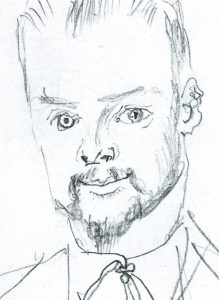 There is no ‘school’ of Klee, he is unique. His art should ‘be read like poems, or listened to like pieces of music’ wrote the critic Georg Schmidt. They can be appreciated for their sound, and for their pure visual appeal; but also for the theory that lies behind. They are based on a ‘perfectly definite melody of colour’ and form. Klee loved Bach and Mozart, and his art mirrored the fusion of these two masters, the fusion of ‘art and intuition… where formal discipline is so miraculously wedded to fantasy and grace’ (J-E Muller).
There is no ‘school’ of Klee, he is unique. His art should ‘be read like poems, or listened to like pieces of music’ wrote the critic Georg Schmidt. They can be appreciated for their sound, and for their pure visual appeal; but also for the theory that lies behind. They are based on a ‘perfectly definite melody of colour’ and form. Klee loved Bach and Mozart, and his art mirrored the fusion of these two masters, the fusion of ‘art and intuition… where formal discipline is so miraculously wedded to fantasy and grace’ (J-E Muller).
Born in 1879, Klee was raised in Bern, the son of musicians (and was a gifted violinist himself). He studied art in Munich, settling there in 1906. In 1911 he met the artists August Macke, Vasily Kandinsky and Franz Marc, who included him (1912) in their movement’s almanac Der Blaue Reiter and their second exhibition. They believed that visual art and music were connected, that art should express spiritual truths. They also believed in the symbolic associations of colour and in an intuitive approach to painting. They were inspired by medieval art, and – prompted by Cubism and Fauvism – the contemporary move towards abstraction.

Having worked mostly in monochrome, a trip to Tunisia in 1914, with Macke and the Swiss painter Louis Moilliet, changed his palette forever: he began working with colour, and absorbed recent developments in non-figurative art. ‘Colour has taken possession of me… Colour and I are one. I am a painter.’ He searched for a ‘style which connects drawing and the realm of colour.’ In Paris he was stunned by the Post-Impressionists, by Cézanne and Van Gogh. ‘Permit me to be scared stiff’ he said, after seeing Van Gogh’s paintings. Klee learnt how colour, and simplified or distorted drawing, could express emotion. But his line always flows, and is key. ‘A drawing is simply a line going for a walk.’
He was opposed to naturalism, but never to nature. ‘See how a butterfly becomes a butterfly… learn to be as rich and versatile and original as nature itself.’
 His work, often quite small, has a lyricism and wit and playfulness rare in ‘serious art’. Klee sought simple means of expression, not through ‘primitive’ sculpture, the source of Picasso’s inspiration (whom Klee admired), but children’s drawings, and those of the insane. He loved the spontaneous expressions of Giotto.
His work, often quite small, has a lyricism and wit and playfulness rare in ‘serious art’. Klee sought simple means of expression, not through ‘primitive’ sculpture, the source of Picasso’s inspiration (whom Klee admired), but children’s drawings, and those of the insane. He loved the spontaneous expressions of Giotto.
He served in the German army from 1916 to 1918, but never saw action. The deaths of Macke and Marc in battle affected him deeply and he created a series of prints on war themes. Luckily for Klee, Germany, in an unlikely mood of enlightenment, sought to protect her surviving artists from the perils of the trenches, and Klee was given a cushy clerical job.
Klee taught at the Bauhaus from 1921 to 1931, where he revelled in competing theories and arguments (particularly with Kandinsky and Mondrian) because ‘the result is achievement’. He taught briefly at Dusseldorf Academy (1931-33) until a Nazi journal called him ‘a typical Galician Jew’ (he was neither); he saw the evil of Hitler and left for Switzerland. In Munich in 1937, the Nazis displayed 17 of Klee’s pictures in their exhibition of ‘Degenerate Art’ (and seized 102 works in public collections). His last works used heavier lines and geometric forms with a few large blocks of colour. Colours alternate between bright and sombre, as death (from scleroderma) loomed. He died in Bern in 1940. His epitaph includes these enigmatic words –  ‘I cannot be grasped in the here and now / For my dwelling place is as much among the dead / As the yet unborn.’ Klee’s art is the boundary between the visible and the invisible, between the finished shape and the formation.
‘I cannot be grasped in the here and now / For my dwelling place is as much among the dead / As the yet unborn.’ Klee’s art is the boundary between the visible and the invisible, between the finished shape and the formation.
Above all, Klee was concerned with bringing order to movement. Perhaps his best loved pictures are those consisting of squares and coloured panels, where geometric shapes are graded in tone or colour, and flow like animation. Art is a process of reduction. Klee simplified, but his was an intentional naivety. He inspired us to look and to feel. He wrote that: ‘Art does not reproduce what we see. It makes us see.’


